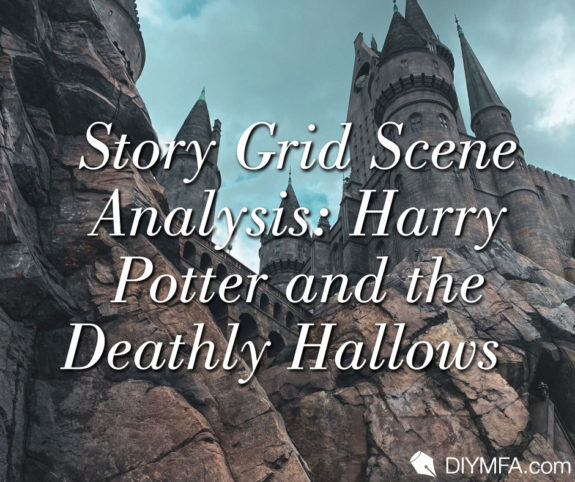Hey writers! In my past few articles we’ve been studying how to read with a purpose, and a fantastic way of leveling up our reading analysis skills is using the Story Grid Scene Analysis Template. As a quick reminder for readers who aren’t familiar with the Story Grid Scene Analysis Template, take a few minutes to review my initial article on this here.
Today, I wanted to address the four questions used in my previous articles, which some writers have shared can feel esoteric. After discussing this with a group of close Story Grid editor friends, we took a crack at simplifying some of the diction used to phrase these questions. I’ve also changed the fourth question in the group to align with some changes Story Grid has made in the past months.
Here are the major changes to the questions you should consider when reading and analyzing a scene, thus determining if it is a scene that works, or advances a plot and/or develops a character:
1. What are the characters literally doing? This question is the same question used in my previous articles. Although standard, it’s important for readers and writers to understand what the characters are literally doing so we can see how they contrast with the obstacles creating conflict in the scene. And almost all–if not all–scenes should have conflict!
2. What is the character’s scene goal and why are they pursuing it? This question simplifies the essential action in a scene—i.e. a character’s want or intention. Knowing what a character wants in a scene sets up a reader’s expectations for how that character advances the plot in a specific moment. Also, knowing that a character wants something and observing how they pursue it makes the scene more purposeful—and interesting—because we understand what’s at stake when conflicts get in his or her way.
3. What life value shift has changed for one or more characters in the scene? Which one of those value changes is most important and should be recorded on the STORY GRID SPREADSHEET? This question pools the major elements determining a scene’s purpose. By identifying the life value in a scene and how it changes from beginning to end, we see what has advanced the plot and/or developed the character on an internal and/or external level. All scenes must change in order to meaningfully contribute to the plot and characters. Scenes that don’t move fall dull and insignificant. So, understanding how a scene changes on the external and/or internal platform will clarify if the scene actually advances the plot, and it illustrates if there has been a polarity shift from beginning to end—i.e. positive to negative, negative to positive, positive to double positive, etc.
4. What Story Event sums up the scene’s literal and essential actions and the value change—i.e. what is a one-sentence synopsis for this scene that we should record on the STORY GRID SPREADSHEET? This is a new and important question! As mentioned in how to analyze a scene (read on to understand this in depth), readers should be able to identify the STORY EVENT for a scene, or an active change of life value for one or more characters as a result of conflict (one character’s desires clash with another’s). Essentially, question four identifies what a character is doing and why, and how certain obstacles—or conflicts—are preventing him/her from pursuing their want with ease.
Now that we’ve simplified and clarified the four questions used to analyze a scene—and read with a purpose! —let’s explore how we can analyze the opening chapter/scene in Harry Potter and the Deathly Hallows.
SUMMARY OF THE SCENE
In the dark of night, two Death Eaters, Snape and Yaxley, appear in a moonlit lane. They address one another and then proceed to Malfoy Manor, where Voldemort currently resides. Immediately, Voldemort directs Snape to sit next to him on his right, and points Yaxley next to a chair beside another Death Eater, Dolohov. The meeting adjourns with Voldemort question Snape’s latest insight. Snape shares the news that Harry Potter will be moved from Privet Drive on “Saturday…at nightfall.” Voldemort is pleased, but shifts his attention when Yaxley says that he had heard a different plan (from Dwalish, an Auror). Snape smiles and assures that this is a false trail. Snape goes on to counter Yaxley’s resistance by confirming that the Order thinks the Ministry is under Voldemort’s control, and that the Auror Office will not oversee Harry Potter’s protection.
Although nearly under the Dark Lord’s control, the Ministry is not yet fully overrun, despite Yaxley’s success at placing the Imperius Curse on Pius Thicknesse, Head of the Department of Magical Law Enforcement. So, Voldemort returns the conversation to their plan to attack Harry Potter. Voldemort likes that the Ministry won’t be able to track Harry, since it will leave Harry out in the open and available for him to attack. Voldemort admits that too many mistakes have been made when it comes to Harry Potter, and even confesses that many have been his own. Voldemort’s company falls silent at this indication, and waits for instructions on how Voldemort plans to kill Harry Potter. Voldemort says he must do this himself.
To do this, Voldemort requires another wizard’s wand. He chooses Lucius Malfoy’s wand, despite Lucius’ extreme discomfort with this. After some cruel banter intended to insult the Malfoy family—specifically regarding Tonks’ recent marriage to Lupin—Voldemort admits that many of the oldest bloodlines become diseased as time passed. In the final moments of the meeting, Voldemort (using Lucius’ wand), summons the floating—and now conscious—body of Charity Burbage, a professor of Muggle Studies at Hogwarts. Using her as an example of what’s to come, Voldemort silences and then murders Professor Burbage, ignoring (like Snape) her direct pleas to Snape to save her. Once dead, Voldemort feeds Charity’s corpse to his snake, Nagini.
ANALYZING THE SCENE
A STORY EVENT is an active change of life value for one or more characters as a result of conflict (one character’s desires clash with another’s).
A WORKING SCENE contains at least one Story Event.
To determine a Scene’s Story Event, answer these four questions:
1. What are the characters in the scene literally doing?
Voldemort and his Death Eaters attend a meeting.
2. What is the character’s scene goal and why are they pursuing it?
Voldemort wants to confirm the best plan of attack on Harry Potter—i.e. he wants to kill Harry himself. On a similar scale, Voldemort also wants a new wand to attack Harry since his wand has a connection with Harry’s wand.
3. What life value shift has changed for one or more characters in the scene? Which one of those value changes is most important and should be recorded on the STORY GRID SPREADSHEET?
Voldemort begins his meeting with the Death Eaters unaware of the current plans for transporting Harry Potter—information he wants desperately in order to plan his attack. Despite some doubts, Snape convinces Voldemort that Harry is being moved on Saturday by a means the Ministry of Magic cannot track, and Voldemort decides that he needs to be the one to kill Harry himself. Voldemort seizes Lucius Malfoy’s wand and uses it to kill Professor Charity Burbage.
Life Values:
- Voldemort: Unaware to Informed
- Lucius: Unnoticed to Humiliated
- Professor Burbage: Life to Death
Life Value for the Spreadsheet (follows Voldemort): Unaware to Informed
4. What is the Story Event that sums up the scene’s literal and essential actions and the value change—i.e. what is a one-sentence synopsis for this scene that we should record on the STORY GRID SPREADSHEET?
Voldemort holds a meeting with his Death Eaters to plan an attack on Harry Potter after Harry leaves Privet Drive, to which there are a couple of possibilities.
HOW THE SCENE ABIDES THE FIVE COMMANDMENTS OF STORYTELLING
- Inciting Incident: Causal. Snape and Yaxley arrive at the meeting.
- Turning Point: Revelation. Snape confirms that Harry will be transported in a way that is not regulated by the Ministry of Magic.
- Crisis: Best Bad Choice. Voldemort—admitting that he’s made mistakes with Harry in the past—debates how Harry Potter should be killed. He can either attack and attempt to kill Harry on his own at the risk of failure, or he can leave someone else to kill Harry—which he, with new knowledge, does not believe will succeed.
- Climax: Voldemort confirms that he must be the one to kill Harry Potter and demands that Lucius Malfoy give him his wand. Though obviously anxious, Lucius gives Voldemort his wand, which Voldemort uses to kill Professor Burbage in front of the company.
- Resolution: Nagini feeds on Professor Burbage’s corpse and Voldemort and his Death Eaters prepare for their attack on Saturday.
Final Thoughts
The world has grown dark by the opening of Harry Potter and the Deathly Hallows, for both the muggle and wizarding world. Although written as its own chapter, the opening of book seven in the series works very much like the opening of books one and six—as a mini-prologue before diving into the third-person limited perspective we will follow for the remainder of the story. This is a clever, stylistic choice on Rowling’s part, as it allows us to sense immediate tension and danger for Harry even before we see him—and especially for when the Order attempts to transport him to The Burrow on broomsticks. We know Snape got the plan right, so we’re given a set up that will be quickly paid off.
Thus, as readers, we’re excited to read what happens to Harry Potter when he leaves Privet Drive, and understand the stakes for when this happens: life and death. Although the opening scene in Harry Potter and the Deathly Hallows works as a subtle prologue that focuses on Voldemort and his pursuits and wants instead of Harry, who is the main POV for the story, the Story Event and other scene essentials in this scene successfully build tension in a way that advances the plot, develops characters, and makes readers nervous for Harry and his friends!
If you’d like to learn more about how to analyze, read, and write a scene with purpose, check out my other articles using the Story Grid Scene Analysis Template on DIY MFA, or visit my website at www.abigailkperry.com. Thanks for joining me for this article today, and happy, mindful reading!

Abigail K. Perry is a Certified Story Grid Editor with professional teaching, literary agency, and film production experience. In addition to writing masterwork guides that help people learn how to write, read, and edit like a writer, she works as a freelance developmental editor/book coach and diagnostic editor, and is a monthly columnist for DIY MFA. Abigail also teaches Genre-Focused writing workshops for the genres she specializes in, which include Women’s Fiction, YA Fantasy, Upmarket Fiction, Historical Fiction, and Scripts. As a podcaster, she’s a passionate advocate for the butterfly effect stories have on the individual and world, which she shares with listeners on her podcast, STORY EFFECT. Visit Abigail’s website if you’re a writer looking for an editor who will help you grow as storyteller, and who has experience in differentiated instruction, traditional publishing, and film.







